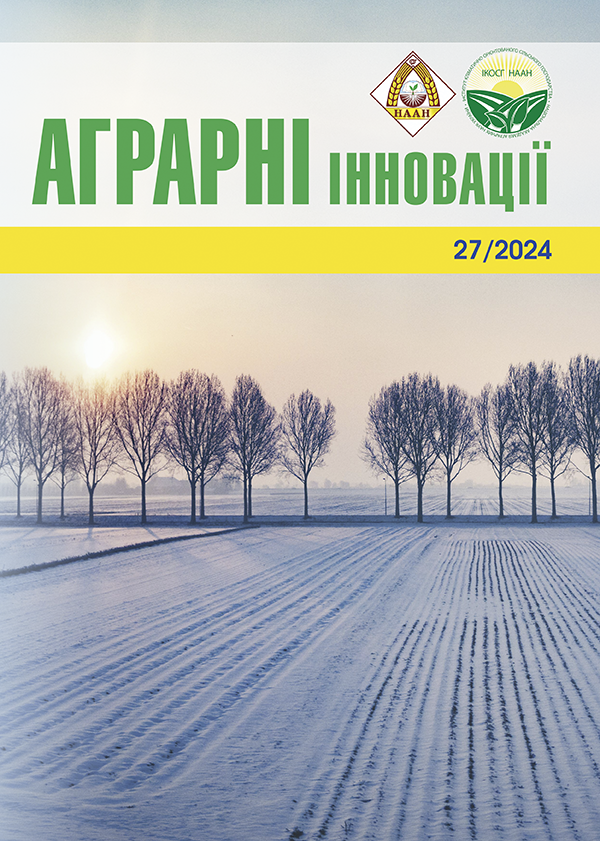INFLUENCE OF NUTRITION OPTIMIZATION ON THE YIELD OF HYSSOPUS OFFICINALIS L. IN THE CONDITIONS OF THE SOUTHERN STEPPE OF UKRAINE
Abstract
Purpose. to determine the influence of nutrition optimization of Hyssopus officinalis L. plantations on crop yield in the Southern Steppe of Ukraine. Methods. Field and laboratory studies were carried out in accordance with modern requirements and standards of research in agronomy and agriculture. Results. On average, over the years of research, the use of mineral fertilizers in a dose of N90P90 provided the highest yield of green aboveground mass of medicinal hyssop plants. Thus, on average, according to the variants of foliar fertilization of plantations of medicinal hyssop in the first year of use, this variant produced 6.24 t/ha of green aboveground mass of plants, which exceeded the control variant of the experiment by 2.76 t/ha or 44.2%. When using the preparation Helafit combi, on average over the years of research and by the factor of the dose of mineral fertilizers, the yield of plants in the first year of use was 5.42 t/ha, which exceeded the variant without the use of foliar fertilization of plantations by 25.5%, respectively. The same trend was observed for the second and third years of planting. In the third year of plantation use, the plants of medicinal hyssop formed the highest yield of green aboveground mass. Thus, on average, 7.51 t/ha of green aboveground mass was obtained in the experimental variants, which exceeded the yield of medicinal hyssop plants in the first year of use by 2.63 t/ha or 35.0%, and in the second year of use by 0.67 t/ha or 8.9%. Conclusions. In the conditions of the Southern Steppe of Ukraine, when optimizing the nutrition of medicinal hyssop, especially in the third year of plantations, the yield of green aboveground mass of plants was the highest – 7.51 t/ha, which is more than the yield of plants of the first and second years of use by 0.67 – 2.63 t/ha. The use of combined use of mineral fertilizers at a dose of N90P90 and foliar fertilization with Helafit combi twice during the growing season provided the highest yield of medicinal hyssop regardless of the year of use of the plantations – 6.84 – 10.01 t/ha.
References
2. Current approaches and challenges for the metabolite profiling of complex natural extracts / Wolfender J. L., Martia G., Thomas A., Bertranda S. Journal of Chromatography A. 2015. 1382. Р. 136–164.
3. Compositional variation in the leaf, flower and stem essential oils of Hyssop (Hyssopus officinalis L.) from Western-Himalaya / Pandey V., Verma R. S., Chauhan A., Tiwari R. Journal of Herbal Medicine. 2014. Vol. 4, Iss. 2. P. 89-95. https://doi.org/10.1016/j. hermed.2013.12.001.
4. Composition, antifungal and antioxidant properties of Hyssopus officinalis L. subsp. pilifer (Pant.) Murb. essential oil and deodorized extracts / Džamić A. M., Soković M. D., Novaković M., Jadranin M., Ristić M. S., Tešević V., Marin P. D. Industrial Crops and Products. 2013. Vol. 51. P. 401-407. https://doi.org/10.1016/j. indcrop.2013.09.038.
5. Effects of exogenous application of citrulline on prolonged water stress damages in hyssop (Hyssopus officinalis L.): Antioxidant activity, biochemical indices, and essential oils profile / Ahmadi H., Babalar M., Sarcheshmeh M. A. A., Morshedloo M. R., Shokrpour M. Food Chemistry. 2020. Vol. 333. 127433. https://doi. org/10.1016/j.foodchem.2020.127433
6. Effect of ultrasound-assisted cold plasma pretreatment on cell wall polysaccharides distribution and extraction of phenolic compounds from hyssop (Hyssopus officinalis L.) / Ahmadian S., Kenari R. E., Amiri Z. R., Sohbatzadeh F., Khodaparast M. H. H. International Journal of Biological Macromolecules. 2023. Vol. 233. 123557. https://doi.org/10.1016/j. ijbiomac.2023.123557
7. Fabrication of double nano-emulsions loaded with hyssop (Hyssopus officinalis L.) extract stabilized with soy protein isolate alone and combined with chia seed gum in controlling the oxidative stability of canola oil / Ahmadian S., Kenari R. E., Amiri Z. R., Sohbatzadeh F., Khodaparast M. H. H. Food Chemistry. 2024. Vol. 430. 137093. https://doi.org/10.1016/j. foodchem.2023.137093.
8. Study on optimization of ultrasonic assisted extraction of phenolic compounds from rye bran / Iftikhar M., Zhang H., Iftikhar A., Raza A., Begum N., Tahamina A., Syed H., Khan M., Wang J. LWT. 2020. Vol. 134. 110243. https://doi.org/10.1016/j.lwt.2020.110243
9. Nadar S. S., Rao P., Rathod V. K. Enzyme assisted extraction of biomolecules as an approach to novel extraction technology: A review. Food Research International. 2018. Vol. 108. P. 309-330. https://doi. org/10.1016/j.foodres.2018.03.006
10. New coating containing chitosan and Hyssopus officinalis essential oil (emulsion and nanoemulsion) to protect shrimp (Litopenaeus vannamei) against chemical, microbial and sensory changes / Mehraie A., Khanzadi S., Hashemi M., Azizzadeh M. Food Chemistry: X. 2023. Vol. 19. 100801. https://doi.org/10.1016/j. fochx.2023.100801
11. Fathiazad F., Hamedeyazdan S. A review on Hyssopus officinalis L.: Composition and biological activities. African Journal of Pharmacy and Pharmacology. 2011. 5 (17). Р. 1959-1966.
12. Effects of agronomic practices on volatile composition of Hyssopus officinalis L. essential oils / Moro A., Zalacain A., Hurtado de Mendoza J., Carmona M. Molecules. 2011. 16 (5). Р. 4131-4139.
13. Rashidi S., Eikani M. H., Ardjmand M. Extraction of Hyssopus officinalis L. essential oil using instant controlled pressure drop process. Journal of Chromatography A. 2018. Vol. 1579. P. 9-19. https://doi. org/10.1016/j.chroma.2018.10.020
14. Naderi G., Mohammadi A., Younesi-Alamouti M. The effect of bio fertilizers, manure and chemical fertilizer on quantity and quality of essential oil of hyssop (Hyssopus officinalis L.). Journal of Medicinal plants and By-Products. 2023. 12. 439–447.
15. Ghanbari-Odivi A., Fallah S., Carrubba A. Optimizing Hyssop (Hyssopus officinalis L.) Cultivation: effects of different manures on plant growth and essential oil yield. Horticulturae. 2024. 10(9). 894. https://doi.org/10.3390/ horticulturae10090894
16. Application of combined fertilizers improves biomass, essential oil yield, aroma profile, and antioxidant properties of Thymus daenensis Celak / Bistgani Z. E., Siadat S. A., Bakhshandeh A., Pirbalouti A. G., Hashemi M., Maggi F., Morshedloo M. R. Industrial Crops and Products. 2018. Vol. 121. P. 434-440. https://doi.org/10.1016/j. indcrop.2018.05.048.
17. Effects of foliar spraying of l-phenylalanine and application of bio-fertilizers on growth, yield, and essential oil of hyssop [Hyssopus officinalis L. subsp. Angustifolius (Bieb.)] / Aghaei K., Pirbalouti A. G., Mousavi A., Badi H. N., Mehnatkesh A. Biocatalysis and Agricultural Biotechnology. 2019. Vol. 21. 101318. https://doi.org/10.1016/j.bcab.2019.101318






